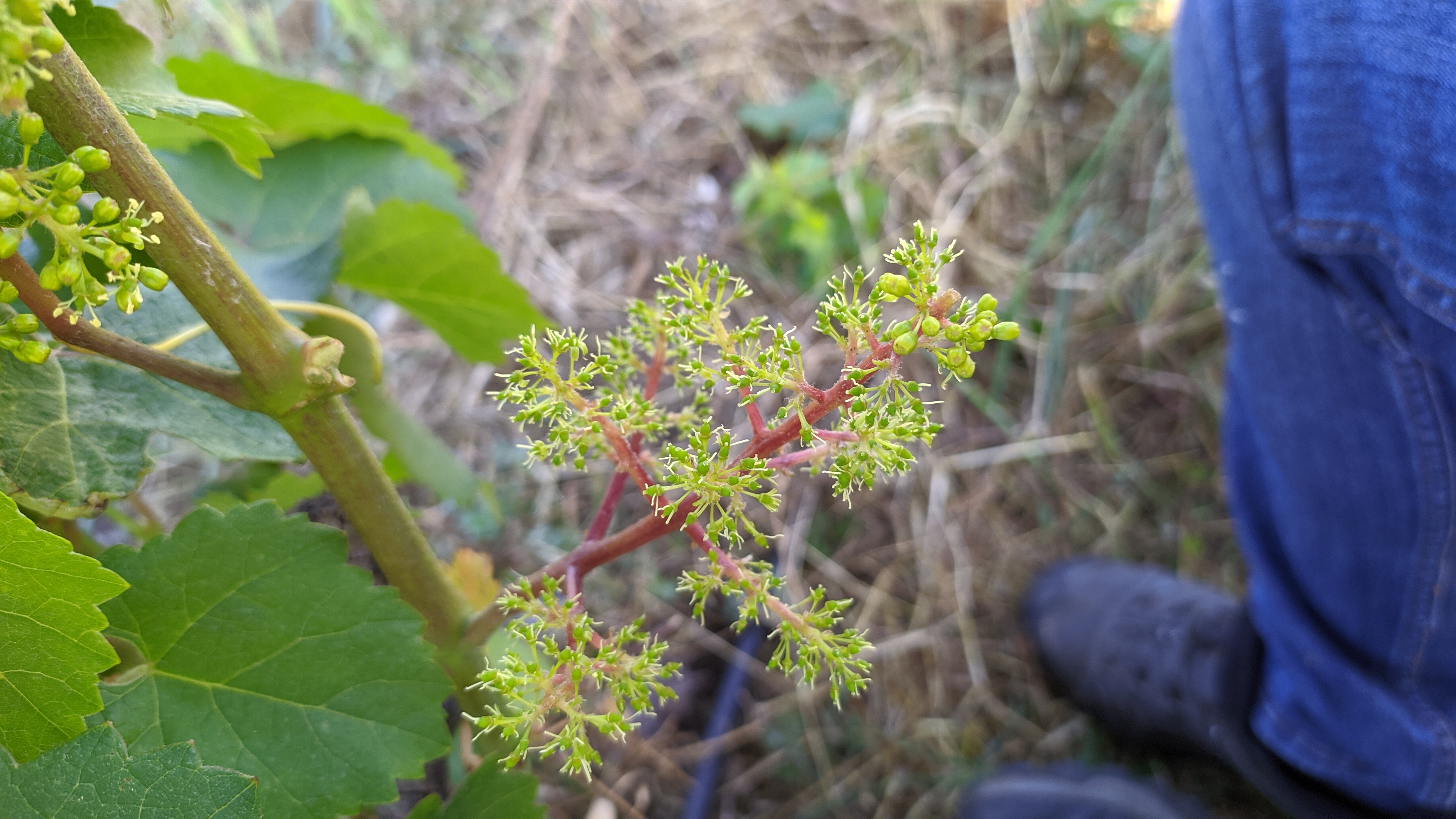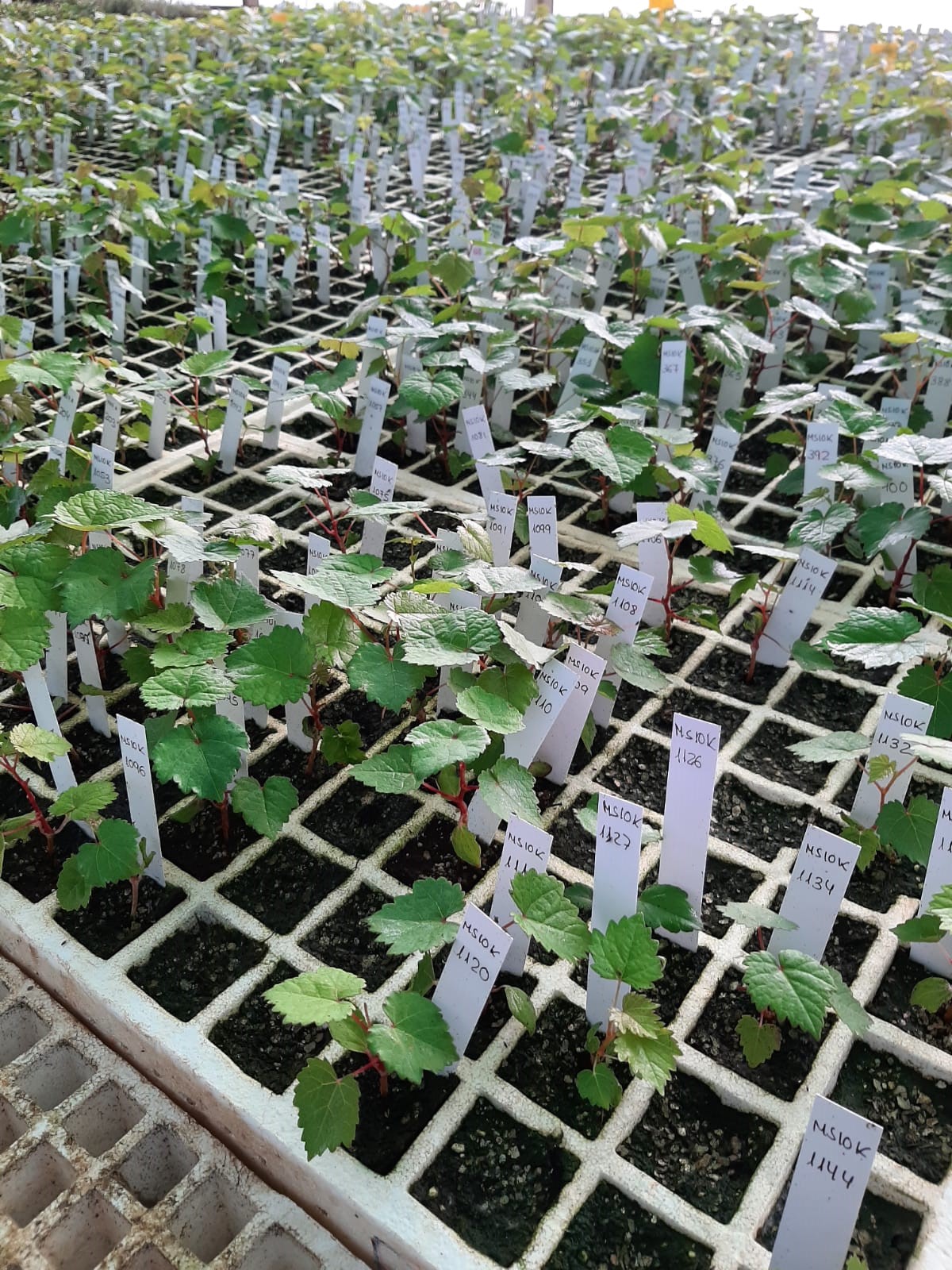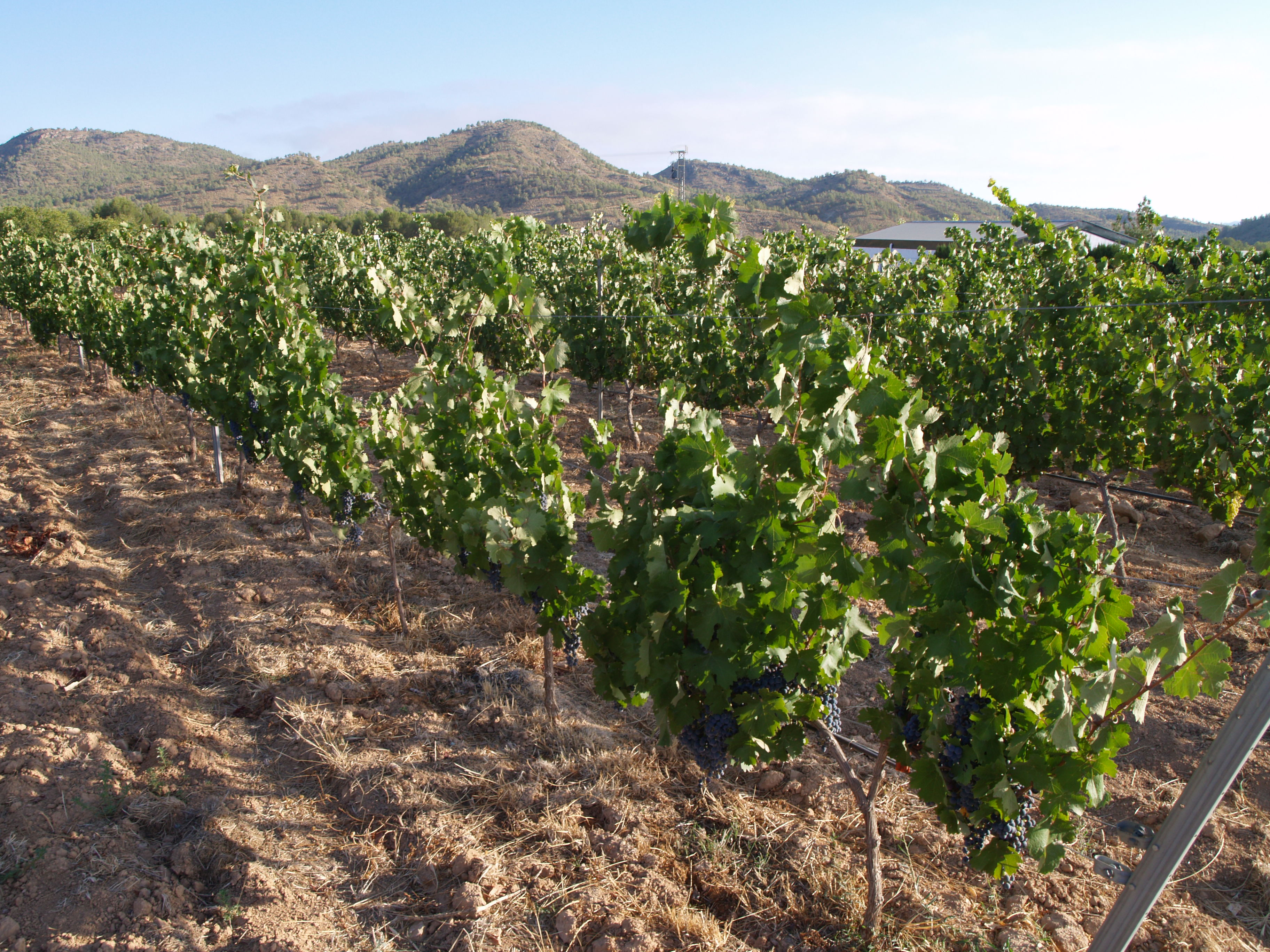
In this second issue of plant breeding success stories we discuss the incredible success of a crossbreeding programs in creating new grapevine varieties that possess improved agronomic and oenological qualities, thereby enhancing the production of quality wine and promoting sustainable viticulture.
The programme was carried out by the Instituto Murciano de Investigación y Desarollo Agrario y Medioambiental, based in Southern Spain. The institute obtained the new ‘Calblanque’, ‘Calnegre’ and ‘Gebas’ varieties from crosses between ‘Monastrell’ and ‘Cabernet Sauvignon’, and the ‘Myrtia’ variety from crosses between ‘Monastrell’ and ‘Syrah’. The new varieties were selected for their phenolic quality—which was very superior to that of the parentals—and for their different harvest dates that allow a staggered harvest and their cultivation in different areas.
This programme demonstrates the potential for crossbreeding programs to generate climate-resistant varieties that are better adapted to the specific conditions of their viticulture zone. Specifically, these new varieties could allow for a better adaptation to the effects of high temperatures on grape and wine quality in semi-arid areas. Moreover, the new varieties described in this work represent a support to the wine sector of the area, which will have an innovative and competitive material of high quality, while maintaining the Mediterranean profile of the wines made with these varieties.
The financial viability of this 27-year-long breeding program was fortified through the protection of the new varieties at the European level, achieved via Community Plant Variety Rights. Moreover, the tests were conducted following CPVO technical protocols and carried out via the Spanish Plant Variety Office (OEVV).
We met with Dr. Ruiz, from the Equipo de Mejora Genética Molecular to discover more about the characterization of new grapevine varieties.
Can you share more about the role of Instituto Murciano de Investigación y Desarollo Agrario y Medioambiental (IMIDA) in these crossbreeding programs and how the institute supports the development of sustainable viticulture?
IMIDA clearly supports the development of sustainble viticulture through its crossbreeding programs. In fact, it is the pioneering national public center registering new varieties of both wine grapes and table grapes. The current climatic scenario of the Region of Murcia, with scarcity of water and high temperatures, is ideal for selecting new varieties that perform better in this semi-arid climate and, therefore, that can better adapt to the negative effects of climate change. Moreover, an breeding program is being developed to obtain vines that in addition to good behavior in semi-arid climates, are resistant to diseases such as powdery mildew and downy mildew, which will drastically reduce the systematic application of phytosanitary treatments.
Furthermore, IMIDA has research team that work on the study and selection of the best vine rootstocks and on the efficient use of water. These research lines are complemented by others such as bioeconomy and circular economy studies, the development of precision viticulture, and with the use of nanoemulsions for a more efficient fertilization and for the application of phytosanitary treatments of natural origin.
All these lines of research, financed in most cases by the European Regional Development Fund (80%-60%) and the Region of Murcia (20%-40%), will contribute to the development of sustainable and environmentally friendly viticulture.
Can you explain the crossbreeding process and the considerations that led you to cross 'Monastrell' with 'Cabernet Sauvignon' and 'Syrah' to produce the new varieties?
The first step in a breeding program is the selection of the parents. Monastrell was selected because it is the reference variety in the Region of Murcia; Cabernet Sauvignon for being a variety of international reference; Syrah for its good adaptation to the area and the good quality of the wines produced. But crosses were also made between Monastrell and other varieties such as Tempranillo, Verdejo or Barberá, varieties that could complement and improve the good attributes of Monastrell.
Initially, the best results were obtained by crossing Monastrell with Syrah and Cabernet Sauvignon. Even so, the registration of three new white varieties has started; one comes from crosses with Cabernet Sauvignon, but the others come from crosses with Verdejo and Tempranillo.
Once the parent varieties have been selected, the bunches of the mother variety (Monastrell) are emasculated before flowering, that is, the stamens are removed, and said bunches are pollinated with the pollen of the varieties selected as fathers (Syrah, Cabernet Sauvignon, Tempranillo, Verdejo or Barberá), applying the pollen with a brush.
When the pollinated bunches are mature, the seeds are extracted and the germination of each of them will be a new genotype from said cross. These germinated seeds are planted in the field, where the agronomic and grape quality will be evaluated for several years. Previously, through the extraction of DNA from each germinated seed and its analysis by PCR with molecular markers, it is verified that the crossing has been carried out correctly, eliminating possible self-fertilization or unwanted pollination with other varieties.
The new genotypes that are selected for their good agronomic and grape quality are multiplied and grafted onto Richter 110 in order to also evaluate the quality of the wine, before applying for registration. At the same time, the genotypes selected for registration are planted in different areas of the Murcia region, in collaboration with winemakers and viticulturists, to check their good behavior and suitability for winemaking.
Once the new varieties passed the DUS (distinctness, uniformity and stability) test and were added to the list of commercial varieties, both at national and community level, the corresponding reports that demonstrate their suitability for winemaking were prepared and sent to the Spanish Ministry of Agriculture, Fisheries and Food, who finally authorized its cultivation for winemaking in the area of Murcia, after examining and approving said reports.
The time that has taken from the starting of the breeding program (1997) to the acceptance of the use of these new varieties for the production of wine in the Region of Murcia (2022) has been 26 years. This work is carried out thanks to the collaboration of the IMIDA Molecular Genetic Improvement and Oenology and Viticulture teams.
Given the increasing global temperatures due to climate change, how will the new genotypes ‘Calblanque’, ‘Calnegre’, ‘Gebas’ and ‘Myrtia’ handle such conditions compared to the traditional varieties like ‘Monastrell’, ‘Cabernet Sauvignon’ and ‘Syrah’?
The Region of Murcia is a warm area, with unfavorable conditions for the production of quality wines. The experimental plot, where the wine grape crossbreeding program is carried out, is located in an area that is classified as arid zone. Following the classification obtained by the Multicriteria Climatic Classification System (Géoviticulture MCC System) for the grape-growing regions worldwide, based on the values obtained for the heliothermal index HI (2,677), the cool night index CI (15.5 ºC) and the dryness index DI (-102.4), the experimental plot is classified in a climatic area HI+2, CI-1, DI+2.
The red varieties, Calnegre, Gebas and Myrtia, have a higher concentration of anthocyanins, for the same Baumé grade, which makes it possible to harvest earlier and avoid the typical storms that can occur in September. Despite the adverse climatic conditions, the concentration of anthocyanins and polyphenols in the new varieties is at least double than that of the parents, which indicates good adaptation to a hot climate. In addition, it is necessary to mention the good behavior that they present in terms of pH values, lower than that of the parents, except for Gebas that has a pH similar to that of the parents. Despite its high phenolic composition, the red wines maintain a Mediterranean profile, with tannins that do not need many years to make the wine easy to drink.
The white variety, Calblanque, does not need acidity corrections, if it is harvested at the right time, and produces wines with a freshness that is not due to the acidity correction.

How do these new grape varieties contribute to sustainability in viticulture, and how might they aid in the adaptation to climate change effects on wine production?
If we consider sustainable viticulture as one that allows the production of high-quality grapes while minimizing the negative impact on the environment and promoting the health of the soil, the vine and the people involved in production, the fact of having selected these varieties for their good performance in an area with water scarcity and high temperatures, places them as very good candidates for their cultivation with less availability of a limited resource such as water and, therefore, it could allow the development of a sustainable viticulture.
Their agronomic and oenological characteristics, previously mentioned, could allow the maintainement of the viticulture in the traditional regions protected by the Denominations of Origin, despite the increase in temperature, allowing the survival of the DOs and of the viticulture activity, as well as the economic and rural development of said zones, with the consequent benefit for the people involved in this activity. Without forgetting the benefit for the soil of maintaining this crop, generally grown on poor soils, in which other crops could not be grown.

What might be the potential impacts of the widespread adoption of these climate-resilient grape varieties on the wine industry's carbon footprint and its overall sustainability goals?
One of the most immediate could be the greater efficiency in the use of water of these new varieties, which could reduce the consumption of a natural resource as valuable and scarce as water. On the other hand, if it is not necessary to abandon the areas currently cultivated with vines, the CO2 fixation by the vineyards will be maintained, in addition to the savings in greenhouse gas emissions, if we have to move the vineyards to higher altitude areas, further away from the wineries and the commercialization areas.
In the case of varieties resistant to powdery mildew and downy mildew, which are also being developed in wine grapes at IMIDA, when they become available, the emission of greenhouse gases produced by phytosanitary treatments will be drastically reduced and, therefore, the wine industry's carbon footprint.
The development of new grape varieties appears to be a viable strategy to mitigate climate change effects on viticulture. How do you believe these methods could be applied to other forms of agriculture or crop production to enhance resilience in the face of climate change?
Supporting crossbreeding programs in other crops, in which new varieties are selected with better adapted to the cultivation areas, with less requirement of consumption of natural resources, and more resistant to pests and diseases to reduce the negative impact of phytosanitary treatments on the environment, and on the health of the people.
In this sense, in addition to the wine grape and table grape improvement programs, IMIDA is also developing other improvement programs with these objectives, in woody species such as citrus and stone fruit trees, as well as in aromatic and horticultural plants.
But in addition to improvement programs, it is important to promote responsible and precision agriculture, which is more environmentally friendly. And for this, the available technology and the knowledge generated in research must be applied.

The tests were conducted following CPVO technical protocols and carried out via the Sanish Plant Variety Office (OEVV). How to you see the role of CPVO in supporting innovation?
The role of the Community Plant Variety Office (CPVO) in innovation is very important. In addition to providing the technical protocols for the characterization of new varieties, it offers help and clarifies all the steps to follow throughout the process of registration and protection of a new variety, processing applications for Community plant variety rights. Thus, it helps uphold breeders' interests, guaranteeing the profitability of investments in research and innovation with intellectual property rights to new varieties, and also provides assistance to growers.
